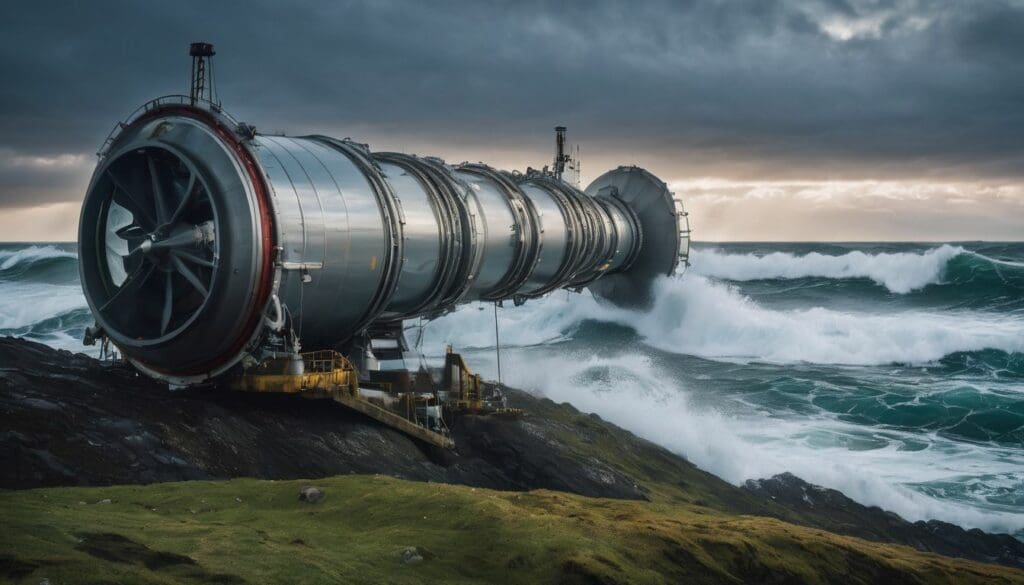As we seek out greener energy options, wave and tidal power stand out with untapped potential. The UK’s coastlines offer one of the best locations worldwide for harnessing ocean energy.
This article dives into how these renewable sources could revolutionise our approach to sustainability. Let’s ride the wave of change!
Key Takeaways
- The UK’s extensive coastline and strong tidal currents make it an ideal location for harnessing tidal energy, with areas like the Pentland Firth offering some of the fastest water currents in the world for potential energy generation.
- Tidal energy is highly predictable and consistent compared to other renewable sources such as wind or solar power; however, it faces high initial costs and environmental concerns which are being addressed through innovative subsea projects and data centre integration.
- The development of tidal energy could lead to substantial job creation across various sectors including engineering, project management, and technology development, strengthening local economies whilst contributing to a sustainable future.
- While current tidal power projects in the UK are limited due to challenges like cost and environmental impact, ongoing advancements indicate that wave and tidal technologies have a promising future in contributing significantly towards reducing carbon emissions in line with conservation efforts.
- Government support through policies that incentivise research, investment, and sustainable practices is crucial for advancing the growth of wave and tidal energy industries within the UK.
The Potential of Tidal Power in the UK
The UK has a prime location for tidal energy, with its extensive coastline and powerful tidal currents. Compared to other renewable energy sources, tidal power has the potential to provide a consistent and reliable source of clean energy.
UK’s prime location for tidal energy
Surrounded by seas, the United Kingdom holds a unique position in tapping into tidal energy. With its vast coastline stretching thousands of miles, it harnesses powerful tides that could provide a significant share of clean energy to the nation.
Tidal stream sectors along coastal areas like the Pentland Firth in Scotland boast some of the fastest currents globally, ideal for generating renewable power.
This prime geographic setting not only makes wave and tidal projects viable but also sets up the UK as a leader in marine energy advancement. Turbine arrays installed underwater capture kinetic energy from tidal streams, converting it into electricity with minimal carbon footprint.
As we turn our attention to overcoming challenges associated with this resource, such initiatives put us at the forefront of sustainable ocean power use and green technology innovation.
Comparison to other renewable energy sources
Tidal energy presents a unique proposition amidst renewable power sources in the UK. Here is how it stacks up against others:
| Energy Source | Pros | Cons |
|---|---|---|
| Tidal Energy |
|
|
| Wind Energy |
|
|
| Solar Energy |
|
|
| Hydroelectric Power |
|
|
| Biomass Energy |
|
|
Tidal energy offers the distinct advantage of being highly predictable compared to solar and wind, giving it an edge in the reliable generation of power.
The Challenges of Tidal Energy
Despite the potential of tidal energy, there are limited existing projects due to high costs and environmental impact. However, innovative solutions such as subsea projects and data centre integration are being developed to overcome these challenges.
Limited existing projects
Tidal power projects in the UK are currently limited, hindering the potential for energy production. Despite this, efforts are underway to develop and expand existing projects. Innovative solutions such as subsea projects and data centre integration hold promise for overcoming these limitations.
Expanding tidal energy initiatives could significantly contribute to carbon reduction and sustainable energy production. With ongoing advancements, the future of wave and tidal energy in the UK is poised for growth and development, offering an alternative source of power generation that aligns with environmental conservation efforts.
High costs
High costs for tidal energy projects can pose a significant challenge to their development. The initial investment required for infrastructure, technology, and maintenance is considerable.
However, the long-term benefits of harnessing tidal power, such as reduced carbon emissions and energy security, can outweigh these costs in the future.
Despite the high costs associated with tidal energy projects, innovative solutions and government support are crucial for overcoming these obstacles and advancing towards a cleaner and sustainable energy future.
Environmental impact
Despite the high costs, tidal energy projects could have a positive environmental impact. As offshore energy sources, they have the potential to reduce reliance on fossil fuels and cut harmful emissions.
Tidal power also has minimal visual impact and does not produce greenhouse gases during operation, making it an attractive alternative energy source.
Moreover, wave and tidal energy could help protect marine life by providing clean electricity without harming ecosystems. By harnessing the power of ocean currents, these renewable resources can contribute to a cleaner and more sustainable future while promoting conservation efforts in the UK’s rich coastal waters.
Innovative Solutions for Tidal Energy
– Subsea projects offer a promising way to tap into tidal energy, while integrating data centres with tidal power can further maximise energy production.
Subsea projects
Subsea projects involve placing tidal turbines under the sea to harness the energy of tidal currents. The technology used in subsea projects is designed to withstand the harsh ocean environment, enabling the extraction of energy from powerful tidal movements. Subsea projects allow for the efficient and sustainable generation of electricity without occupying land space or interfering with marine activities. Additionally, these projects have minimal visual impact and reduce potential conflicts with other sea users, making them an environmentally friendly option for renewable energy generation.
Data centre integration
Data centre integration plays a crucial role in the development of tidal power projects. By linking tidal energy generation to data centres, excess energy can be stored and utilised more effectively.
This integration maximises the efficiency of wave and tidal energy systems and contributes to a more sustainable power supply for the UK.
Furthermore, data centre integration supports job creation in the renewable energy sector, providing opportunities for skilled workers as part of the country’s commitment to hydrokinetic energy solutions.
The potential impact on job creation demonstrates how embracing innovative technologies like this can benefit both the environment and local economies.
Government Support and Policies
The UK government plays a crucial role in supporting tidal energy through forward-thinking policies and incentives. With the potential for job creation and a cleaner, more sustainable future, embracing tidal energy is essential for the country’s renewable energy goals.
Need for forward-thinking policies
Developing forward-thinking policies is crucial to harness the full potential of wave and tidal energy. These policies should prioritise investment in research, development, and infrastructure to support the growth of this renewable energy sector.
By incentivising innovation and sustainable practices, these policies can pave the way for a cleaner and more sustainable future.
Forward-thinking policies will create an environment that encourages private investment in wave and tidal energy projects. This will not only drive economic growth but also contribute significantly to reducing carbon emissions, helping the UK achieve its environmental targets.
Potential for job creation
The expansion of tidal energy projects in the UK holds significant potential for job creation. As the industry grows, it will require a skilled workforce to design, build, and maintain the infrastructure needed for harnessing tidal power.
This includes opportunities in engineering, project management, manufacturing, and renewable energy technology development. The growth of this sector could also stimulate employment in support services such as logistics, research and development, and environmental monitoring.
Enabling more individuals to find gainful employment while contributing to a sustainable future is just one way tidal energy can positively impact UK communities. Furthermore, with an increased focus on green technologies and innovation within the renewable energy sector.
Conclusion: Embracing Tidal Energy for a Cleaner and More Sustainable Future
The potential for tidal power in the UK is significant, with its prime location and comparability to other renewable energy sources. Despite challenges such as limited existing projects and high costs, innovative solutions like subsea projects and data centre integration are paving the way.
With forward-thinking government support and policies, embracing tidal energy could lead to job creation and a cleaner, more sustainable future for the UK.
FAQs
1. What is wave and tidal energy?
Wave and tidal energy are forms of renewable power created by harnessing the natural movements of ocean waves and tides.
2. Why is the future of wave and tidal energy important for the UK?
The UK’s long coastlines make it ideal for capturing wave and tidal energies, which can provide a clean, sustainable source of electricity for the future.
3. Can wave and tidal energy significantly contribute to the UK’s power needs?
Yes, with ongoing advancements in technology, wave and tidal energy have potential to meet a significant portion of the UK’s demand for electricity.
4. Are there any plans to expand wave and tidal energy projects in the UK?
The government is actively supporting research into improving technologies so that more efficient use of these resources will play an essential role in powering homes across the country.





